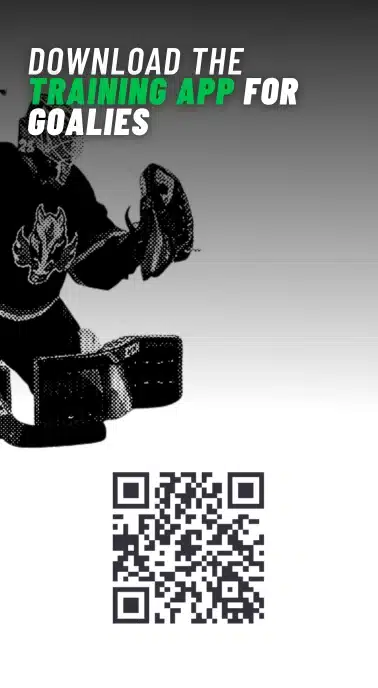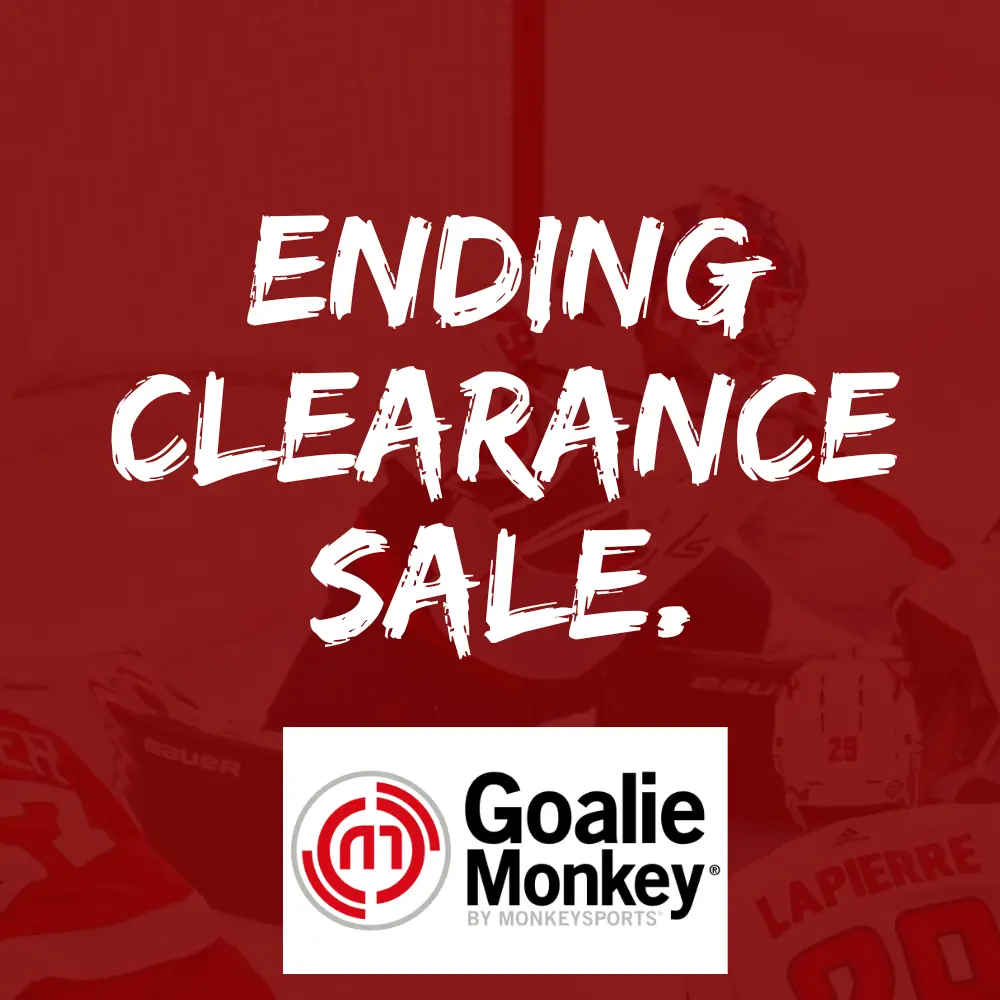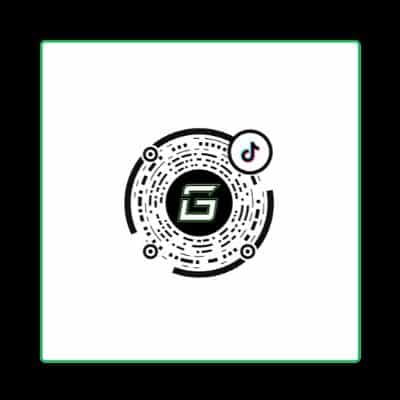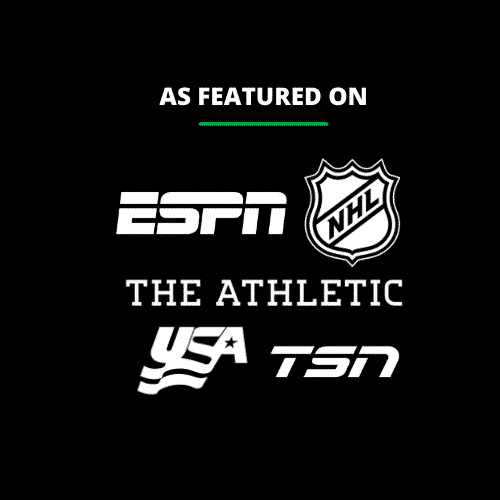Skate sharpening.
Get it right and you’ll take it for granted.
Wrong, on the other hand, can turn what should’ve been a great practice/game into a nightmare. I may just be a goalie writing this, however, it seems that with goalie skates it’s even more critical that we get a spot on sharpening. As many goalies would agree, there is nothing worse than stepping on to the ice only to discover that you’re missing an edge.
Before you read.. as a goalie, I was having a terrible time finding a place to get my skates sharpened, so I bought a Sparx Skate Sharpener. With a Sparx, you just put your skates in and press “Go”. It sharpens them for you. Here’s my full review of the Sparx. We’ve been using this machine for 5+ years and believe there is no better way to sharpen goalie skates.
Are you a goalie or a goalie parent? enroll in one of our goalie specific training programs (online) for unreleased drill videos, workouts, and massive discounts in the Goalie Coaches store.
In this article, we’re going to cover the nuances of learning to sharpen goalie skates. We’ll cover things like:
- Instructions on how to sharpen goalie skates
- What hollow should you sharpen your skates at?
- How sharp should my skates be? Understanding skate blade radius
- Diagnosing problems with sharpening your skates, like lack of grip or dull edges
- Skate sharpening frequency
- Do new skates need to be sharpened?
Own a skater sharpener yet? We’ve been using the Sparx sharpener since 2019 (we’re currently have two of the Sparx machines), have done thousands of individual goalie skate sharpenings on it and recommend it to anybody who asks. More information on skate sharpeners here.
I have used this skate sharpening system for 8+ years. My original Sparx sharpener works as well as the day I got it and I'd recommend it to anybody. In December of 2024, I switched to the Bauer Pro Sharp system, more on that here.
How to sharpen goalie skates
Sharpening goalie skates is exactly like sharpening player skates, except the shop should have experience with goalie skates. It’s best to use word of mouth to find a reputable skate sharpening shop, as the grinding wheel needs to be adjusted slightly prior to sharpening goalie skates. This is due to the fact that goalie skate blades are slightly wider than those used on regular hockey skates.
- Get a skate sharpener (we use the Sparx, full review here)
- Determine your hollow (1″ equals more glide, 3/8″ equals less)
- Sharpen the skates to your desired edge
- Use a honing stone to remove burrs / etc.
What hollow should I sharpen my goalie skates at?
We’ve built a highly exaggerated graphic to help you understand the “hollow” of your skates.
If you’re unfamiliar with what a hollow is, it’s the indent created when a grinding wheel runs along the skate blade. This hollow is often referred to as the “skate sharpening radius”. The skate hollow created by sharpening either creates more or less friction with the ice.
These are the most common radius, or “hollow” that goalie skates are sharpened at.
- For beginners and young goalies, 1/2″ is most common as it is the median option for skate blade radius
- If you want a goalie skate with more grip and less glide, the a radius from 7/16″ – 3/8″ is popular
- Goalies who want less resistance should use a radius from 1/2″ to 1″, though it’s not common to choose a radius higher than 7/8″
For goalies who have never used goalie skates before, we recommend starting at 1/2″. If you can skate easily and feel like you’re not getting enough grip, try a radius closer to zero, like 7/16″, for more grip. Be aware, however, that the closer your skate blade radius gets to zero, the less glide you’ll have.
Understanding what radius goalie skates should be sharpened at is as simple as remembering what “radius” actually means. The radius in skate sharpening is defined as “the amount of blade removed by a grinding wheel”. When a skate sharpener removes more of this blade, the radius number approaches zero inches. When less of the skate blade is removed, the radius approaches 1″. The radius that’s most common throughout goaltending is 1/2″ as it is right in the middle of sharper and more dull.
Whether you’re a goalie or a skater, the hollow stays the same. Goalie blades are a bit wider than a skaters, so the skate sharpener tunes the grinding wheel prior to sharpening. It’s important to note, however, that you still order your skates sharpened at the same hollow.
On the left side of our photo, a 1″ hollow shows hardly any indent in the blade. This gives a skater or a goalie more glide, as most of the blade is touching the ice. On the opposite end of the spectrum, a 3/8″ hollow cuts the ice much harder and as a result, digs in further to glide.

Skate Sharpening Hollow Chart
Skate sharpening hollows are measured in inches. For the deepest hollow, the further away from 1″, the more the blade is hollowed out providing maximum grip. For shallow hallows and more glide, hollows that are closer to 1″ should be used.
| Hollow Measurement |
Hollow Description
|
| 5/16″ |
Deepest Hollow, Max Grip
|
| 3/8″ |
Popular Grip Hollow
|
| 7/16″ |
1/2″ is More Common
|
| 1/2″ |
Most Common for Skaters and Goalies
|
| 9/16″ |
Very Popular for Goalies
|
| 5/8″ |
Popular for Skaters
|
| 11/16″ | Less Grip |
| 3/4″ |
2nd Most Common Hollow
|
| 7/8″ |
Almost No Hollow
|
| 1″ | Rarely Used |
| 1 + 1/8″ | 2nd Most Glide |
| 1 + 1/4″ |
Shallowest Hollow, Most Glide
|
How sharp should goalie skates be? More Glide or Max Grip?
This is about the only thing you’ll need to remember when it comes to getting your skates sharpened. As you get closer to 1″, there’s less of the blade “cut out” or “hollowed”, and you’re gliding more. The further a hollow goes from 1″, the more cut you’re getting with the ice and in theory.. less glide.
In the video below from our friends over at Pure Goalie, they cover a pretty critical point. No matter what you decide to do, there really isn’t a “standard” for goalie skate sharpening.
My skates have no edge, what happened?
On a traditional sharpener, it’s quite easy to mess up a skates edge. Find a local skate sharpening shop that gets your skates right every time and stick with them. You’ll be glad you did.
(or go buy the Sparx automatic sharpener, like I did)
There will generally be a couple things wrong with a bad skate sharpening.
- Your skates edges could be unbalanced. Place a coin on the skate blade. Does it lean one way or the other? If so, your edges are not perfectly aligned. This will cause your skates to feel like they may not have an edge at all!
- Did your skate sharpening shop run a stone on the edges afterwards? “Stoning” your skates is very important, especially after a sharpening. Without doing this properly, a skates edge can actually curl just a bit outwards, causing it to feel like there actually isn’t an edge — even when the sharpener did a good job on the skates.
*it’s not a terrible idea to buy a skate stone for your bag, especially to work out nicks and burrs.
How often should I sharpen my goalie skates?
How often you should sharpen your goalie skates is a choice of personal preference. Many of the professional goalies we work with sharpen their skates on a daily basis. Other goalies, like NHL netminder Robin Lehner, sharpen their skates on a very limited basis. Robin Lehner actually only sharpens his skates once per year. The only disadvantage to over-sharpening your goalies skates is that over time, your skate blades will wear out faster.
Typically, we see goalies at lower levels sharpen their skates once a week, or bi weekly. The need to sharpen skates on a more consistent, regular basis however, drastically shortens this time period.
For goalies especially, it’s next to impossible to find somebody who knows how to properly sharpen goalie skates.
I got fed up and bought the Sparx sharpener. The Sparx sharpener allows anybody to sharpen their skates from home, with zero experience. Plus, it’s cheaper than regular sharpeners. Here are my thoughts.
Do new skates need to be sharpened?
New skates should always be sharpened before their first use. Skates are not sharpened before they leave the factory, so that goalies and players can sharpen them to their liking before they take the ice. Skating with a brand new pair of skates that have not been sharpened is not only less enjoyable, it can be considered dangerous.
One of the questions we get all the time on goalie skates is after the purchase has actually happened. Should I be sharpening my new goalie skates? The answer to that is yes, new skates should always be sharpened, especially if you’ve purchased them online. There are ways to check if your skates are sharp, but as a rule of thumb, we should always start with a fresh edge.
If you don’t own your own skate sharpener, it’s recommended that you take them to a reputable hockey shop. Hockey shops have experience sharpening goalie skates where a home based skate sharpener may not, so they’re well versed in the ins and outs of sharpening your goalie skates.
Which brings up a point we talked about earlier. Sharpening goalie skates is quite a bit different than sharpening your normal hockey skates. There are some adjustments that have to be done to the grinding wheel prior to sharpening and it is possible to have them sharpened incorrectly if the proper steps are not taken to prepare the grinding stone.
What Skate Sharpener Should I Use For Goalie Skates?
Without question, the single best investment a hockey parent can make is in a home skate sharpener. We recommend the Sparx, only because we’ve used it for over 5 years and have not had a single issue. We own two of these machines, one stays at home and the other travels to every rink we go to.
I have used this skate sharpening system for 8+ years. My original Sparx sharpener works as well as the day I got it and I'd recommend it to anybody. In December of 2024, I switched to the Bauer Pro Sharp system, more on that here.
We hope this article was helpful. Should you have additional questions, we recommend taking a look at our resources for Goalie Parents, or joining the Goalie Parents Facebook Group. There are over 20,000 parents of goalies in the group, it’s a wealth of knowledge for all things goalie related. There are even parents of current NHL goalies in there!








